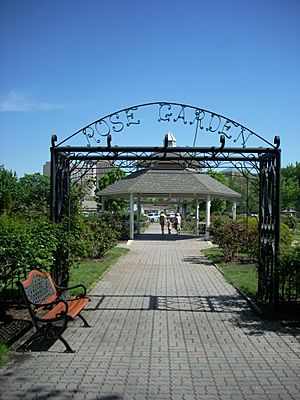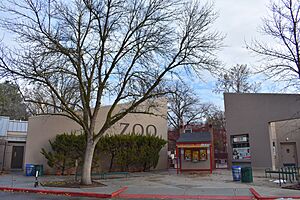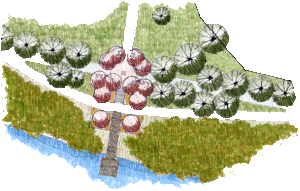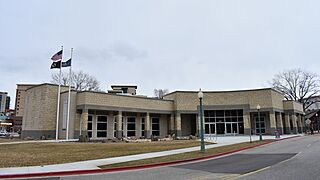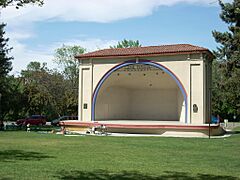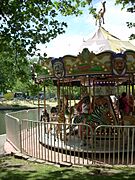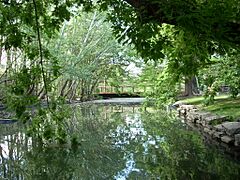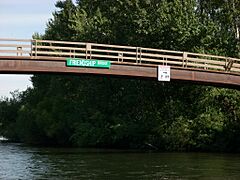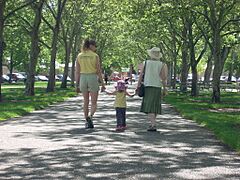Julia Davis Park facts for kids
Quick facts for kids Julia Davis Park |
|
|---|---|
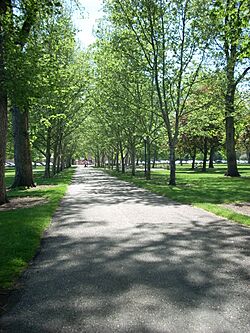
One of many paths in the park.
|
|
| Lua error in Module:Location_map at line 420: attempt to index field 'wikibase' (a nil value). | |
| Type | Municipal park |
| Location | 700 S. Capitol Blvd. Boise, Idaho, U.S. |
| Area | 89.4 acres (36.2 ha) |
| Created | November 22, 1907 |
| Etymology | Julia Davis, wife of Thomas Jefferson Davis, who donated the land |
| Operated by | Boise Parks and Recreation |
| Status | Open all year, from sunrise to midnight |
Julia Davis Park is a cool park in Boise, Idaho. It's located right in the heart of downtown. This park was created in 1907. It started with land given by Thomas Jefferson Davis. He wanted to honor his wife, Julia Davis.
The park is the first in a group of parks called the "String of Pearls." These parks are all along the Boise River. The city's Parks and Recreation Department takes care of them.
Julia Davis Park is a central spot in Boise. It has many fun places to visit. You can find museums like the Boise Art Museum. There's also the Idaho State Historical Museum and the Idaho Black History Museum. Other cool spots include Zoo Boise and the Gene Harris Band Shell. The Boise River Greenbelt path goes right through the park. You can also rent paddle boats on the pond. A bridge connects the park to Boise State University.
Contents
History of Julia Davis Park
The story of Julia Davis Park began in 1862. Thomas and Frank Davis came to Boise from Ohio. They hoped to find gold in the Idaho Territory. The brothers built a cabin in 1863. It was near where the park is today.
On July 4, 1863, Fort Boise was built. Soon after, the Davis brothers and friends planned the city of Boise. Thomas Davis helped Boise grow. He planted 7,000 apple trees on his land. He also bought a lot of land in the valley.
In 1871, Thomas married Julia McCrumb. She had moved to Boise from Canada. In 1899, the couple offered some of their land for a park. The city didn't take the offer right away. They offered the land again in 1907.
After Julia Davis passed away in September 1907, Thomas gave 40 acres of land to the city. He did this in memory of his wife. He said the land must always be used for public purposes. It also had to be known as Julia Davis Park forever. If the city used it for anything else, the land would go back to the Davis family. Thomas Davis died the next year in 1908. Many people in Boise respected the couple for their kindness.
Park Improvements and Growth
After Thomas Davis died, the city worked on the park. They added walls and planted trees. In 1916, the Boise Zoo was created. It's now called Zoo Boise. The park grew with more land donations in the 1920s and 1930s.
A bandshell was built in 1928. The Boise Zoo also got bigger in 1929. In 1931, the Capitol Boulevard Memorial Bridge was built next to the park. A beautiful rose garden was added in 1939. The park expanded to its current size in the early 1940s.
In 1950, the Idaho Historical Museum opened in the park. In 1959, Union Pacific gave a large train engine called "Big Mike" to the park. The city started building the Boise River Greenbelt in 1966. In 1980, the Bob Gibb Friendship Bridge was built. It connects the park to Boise State University.
The Boise Gallery of Art became the Boise Art Museum in 1986. It expanded a lot by 1997. The Idaho Black History Museum opened in 1998. In 2002, a statue honoring pioneers like Julia Davis was added. In 2007, the park celebrated its 100th birthday!
Cool Places to Visit
Julia Davis Park is home to several exciting attractions.
Boise Art Museum
The Boise Art Museum (BAM) started in 1931. It's a main spot for art in Boise. The museum brings amazing art to the community. Every year, BAM hosts "Art in the Park." This event brings together local artists and businesses. It's a fun way to see art and support the community.
Idaho Black History Museum
The Idaho Black History Museum is right next to Julia Davis Park. It opened in 1995. This museum is the oldest black history museum in the Pacific Northwest. It shows Idaho's rich history and diversity. The museum helps people learn about important events and people.
Idaho State Historical Museum
The Idaho State Historical Museum opened in 1907. The Idaho State Historical Society runs it. The museum has exhibits about Native American, Basque, and Chinese cultures. You can learn a lot about Idaho's past here.
Rose Gardens
The idea for a rose garden came from H.C. Schuppel in 1935. He was part of a rose garden club. Work on the garden began in 1939. They planted 2,800 roses! The Rose Garden was officially opened that same year.
In 1979, the Memorial Rose Fund was started. This fund helps create memorials in the garden for loved ones. The Rose Garden got national recognition in 1992. It became a Public Rose Garden. Because of this, it gets 10 new "All American" rose bushes every year. Many weddings also happen in this beautiful garden.
Discovery Center of Idaho
The Discovery Center of Idaho is next to Julia Davis' pond. It was finished in 1988. Its goal is to make people interested in science, technology, engineering, and math (STEM). It's a great place for hands-on learning and fun experiments.
Gene Harris Bandshell
The Gene Harris Bandshell is inside Julia Davis Park. It hosts many free concerts for park visitors. It brings music and culture to everyone. The bandshell was built in 1928. It was named after Gene Harris in 2001. Famous musicians like The Velvet Underground and Pete Seeger have played there.
Zoo Boise
Zoo Boise started in 1916. It happened after a monkey escaped from a circus in Mountain Home. The monkey was found later in the desert. Boise became its new home, and the zoo was founded! Zoo Boise brings many visitors to Julia Davis Park.
In 2008, Zoo Boise opened a big African Plains exhibit. It has an African Village and areas for different animals. You can see rock hyrax, weaver birds, and lemurs. There are also African lions, striped hyenas, giraffes, zebras, amur leopards, snow leopards, penguins, red pandas, and tigers. There's also a building for primates and an aviary for birds.
In 2018, construction started on a new 3-acre area. It focuses on Gorongosa National Park in Mozambique. This new area opened in 2019. It added olive baboons, African painted dogs, vervet monkeys, crocodiles, and warthogs. The old primate house was replaced with a new plaza. It has exhibits for gibbons and sarus cranes. More than 350,000 people visit the zoo each year!
Zoo Boise also has a Conservation Fund. This fund helps protect animals locally and globally. In the last ten years, it has given over $3 million to conservation projects. These projects are in places like Mozambique, Boise, Asia, and Central America. The zoo gives more than 10% of its money to conservation every year.
Future Plans for the Park
There are exciting plans for Julia Davis Park! These include a new "Grand Plaza" for big events. There will also be a history walk with new pavilions. Four new "river nodes" will be added. A new "Golden Apple" history tour is also planned.
The Grand Plaza will be a large, open space. It will have a bronze medallion in the ground. This area will be great for social gatherings and events. Five new or updated pavilions will offer picnic spots, concert areas, and gathering spaces.
The five river nodes will show off Boise's wildlife and the river's beauty. Each node will have a special pedestal. It will share information about the park's history. The history walk will connect different sites with historical facts. The "Quest for the Golden Apple" will have thirteen stops. Each stop will teach you about Idaho's history and nature.
Gallery
-
The Friendship Bridge connecting the park with the Boise State University campus.



